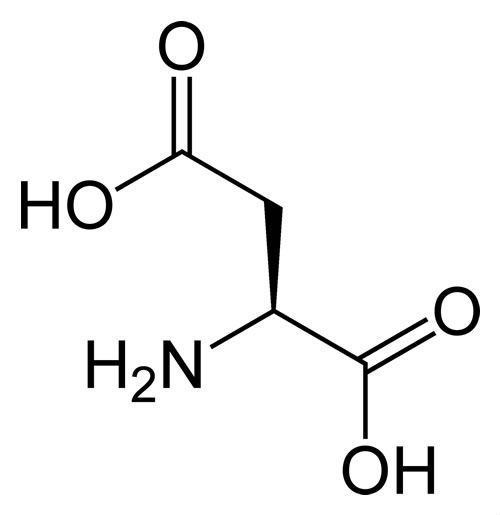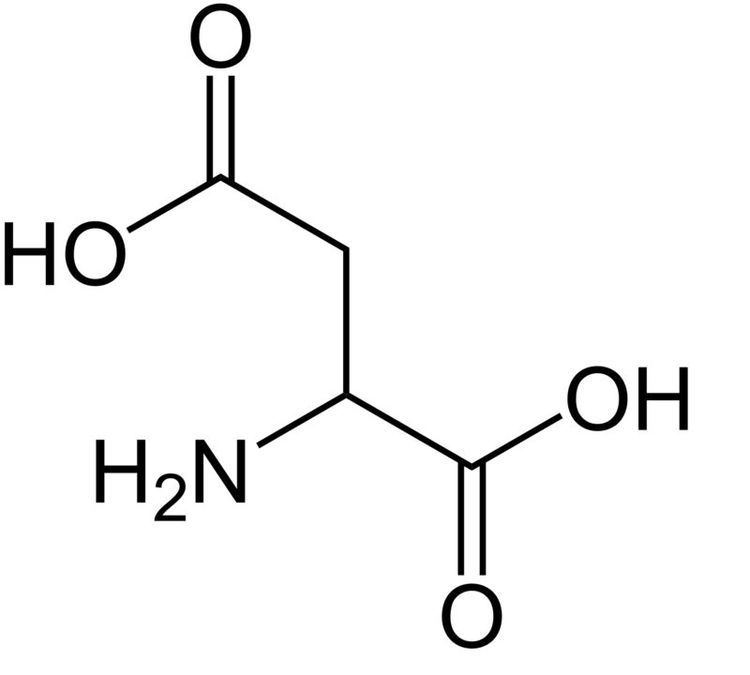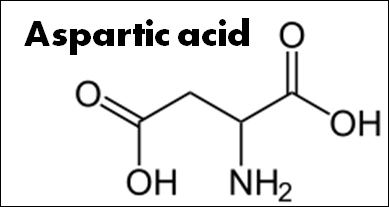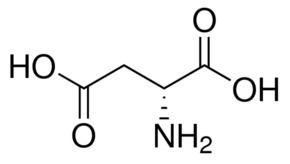Formula C4H7NO4 IUPAC ID 2-Aminobutanedioic acid Density 1.7 g/cm³ | Molar mass 133.11 g/mol Appearance colourless crystals | |
 | ||
Thermodynamicdata Phase behavioursolid–liquid–gas | ||
Aspartic acid meaning
Aspartic acid (abbreviated as Asp or D; encoded by the codons [GAU and GAC]), also known as aspartate in its deprotonated form, is an α-amino acid that is used in the biosynthesis of proteins. Similar to all other amino acids it contains an amino group and a carboxylic acid. Its α-amino group is in the protonated −NH+3 form under physiological conditions, while its α-carboxylic acid group is deprotonated −COO− under physiological conditions. Aspartic acid has an acidic side chain (CH2COOH) which reacts with other amino acids, enzymes and proteins in the body. Under physiological conditions (pH 7.4) in proteins the side chain usually occurs as the negatively charged aspartate form, −COO− . It is semi-essential in humans, meaning the body can synthesize it through the transfer of an amino group, or transamination, of oxaloacetate by alanine or glutamate. Additionally, Aspartate is the precursor for other the synthesis of other amino acids such as: Lysine, Threonine, and Methionine.
Contents
- Aspartic acid meaning
- D aspartic acid
- Discovery
- Biosynthesis
- Chemical synthesis
- Forms and nomenclature
- Metabolism
- Participation in the Urea Cycle
- Other biochemical roles
- Interactive pathway map
- Neurotransmitter
- Applications Market
- Supplement industry
- References

D-Aspartate is one of two D-amino acids commonly found in mammals.[3] All other amino amino acids occur in, and are used by the body in their L confirmation.

In proteins aspartate sidechains are often hydrogen bonded, often as asx turns or asx motifs, which often occur at the N-termini of alpha helices.

Asp's L-isomer is one of the 22 proteinogenic amino acids, i.e., the building blocks of proteins. Asp (and glutamic acid) is classified as acidic, with a pKa of 3.9, however in a peptide this is highly dependent on the local environment (as with all amino acids), and could be as high as 14. Asp is pervasive in biosynthesis.

D aspartic acid
Discovery
Aspartic acid was first discovered in 1827 by Auguste-Arthur Plisson and Étienne Ossian Henry, derived from asparagine, which had been isolated from asparagus juice in 1806, by boiling with a base. After Asparagine is boiled with a strong base it must be hydrolyzed by either acid or alkali in order to yield aspartate. [5]
Biosynthesis
Because Aspartate can be synthesized by the body it is classified as a non-essential amino acid. In the human body, aspartate is most frequently synthesized through the transamination of oxaloacetate. The biosynthesis of Aspartate is facilitated by a class of enzyme called an aminotransferase. In other words, the transfer of an amine group by this enzyme from another molecule (i.e. alanine, glutamine) yields aspartate and an alpha-keto acid. However, although aspartate is most commonly synthesized from oxaloacetate, it is also a byproduct of the urea cycle.
Aspartate is also involved in the synthesis of other amino acids such as: Lysine, Threonine, and Methionine
Chemical synthesis
Racemic aspartic acid can be synthesized from diethyl sodium phthalimidomalonate, (C6H4(CO)2NC(CO2Et)2).
The major disadvantage of the above technique is that equimolar amounts of each enantiomer are made. Using biotechnology it is now possible to use immobilised enzymes to create just one type of enantiomer owing to their stereospecificity.
Forms and nomenclature
There are two forms or enantiomers of aspartic acid. The name "aspartic acid" can refer to either enantiomer or a mixture of two. Of these two forms, only one, "L-aspartic acid", is directly incorporated into proteins. The biological roles of its counterpart, "D-aspartic acid" are more limited. Where enzymatic synthesis will produce one or the other, most chemical syntheses will produce both forms, "DL-aspartic acid," known as a racemic mixture.
Metabolism
Aspartate is non-essential in mammals, being produced from oxaloacetate by transamination. In plants and microorganisms, aspartate is the precursor to several amino acids, including four that are essential for humans: methionine, threonine, isoleucine, and lysine. The conversion of aspartate to these other amino acids begins with reduction of aspartate to its "semialdehyde," O2CCH(NH2)CH2CHO. Asparagine is derived from aspartate via transamidation:
-O2CCH(NH2)CH2CO2- + GC(O)NH3+ O2CCH(NH2)CH2CONH3+ + GC(O)O(where GC(O)NH2 and GC(O)OH are glutamine and glutamic acid, respectively)
Participation in the Urea Cycle
In the Urea cycle, Aspartate and Ammnonia donate amino groups leading to the formation of Urea
Other biochemical roles
Aspartate has many biochemical roles. Aspartate is a metabolite in the urea cycle and participates in gluconeogenesis. It carries reducing equivalents in the malate-aspartate shuttle, which utilizes the ready interconversion of aspartate and oxaloacetate, which is the oxidized (dehydrogenated) derivative of malic acid. Aspartate donates one nitrogen atom in the biosynthesis of inosine, the precursor to the purine bases. In addition, aspartic acid acts as hydrogen acceptor in a chain of ATP synthase.
Through recent advances in technology, aspartate has been found to play vital roles in hormone production and secretion. Additionally aspartate has been shown to play a role in the regulation of neuronal transmission.
Interactive pathway map
Click on genes, proteins and metabolites below to link to respective articles.
Neurotransmitter
Aspartate (the conjugate base of aspartic acid) stimulates NMDA receptors, though not as strongly as the amino acid neurotransmitter L-glutamate does.
Applications & Market
The global market for aspartic acid is $117MM annually (50-60K MT/Yr) with areas of growth accounting for an addressable market of $8.78BB. The three largest market segments include the U.S., Western Europe, and China. Current applications include biodegradable polymers (polyaspartic acid), low calorie sweeteners (aspartame), scale and corrosion inhibitors, and resins.
Nearly all aspartic acid is manufactured in China.
Superabsorbent polymers
One area of aspartic acid market growth is biodegradable superabsorbent polymers (SAP). The super absorbent polymers market is anticipated to grow at a CAGR of 5.5% from 2014 to 2019 to reach a value of $8.78BB globally. Around 75% of superabsorbent polymers are used in disposable diapers and an additional 20% is used for adult incontinence and feminine hygiene products. Polyaspartate, the polymerization product of aspartic acid, is a biodegradable substitute to polyacrylate. The polyaspartate market comprises a small fraction (est. < 1%) of the total SAP market.
Additional uses
In addition to SAP, aspartic acid has applications in the $19B fertilizer industry, where polyaspartate improves water retention and nitrogen uptake; the $1.1B (2020) concrete floor coatings market, where polyaspartic is a low VOC, low energy alternative to traditional epoxy resins; and lastly the >$5B scale and corrosion inhibitors market.
Supplement industry
D-Aspartic acid has been shown to increase levels of Luteinizing hormone as well as testosterone in men. Its effectiveness in boosting these hormones has led to its popularity in the supplement industry where it is marketed and sold as a testosterone booster. Additionally, it has been proven to increase fertility and sperm motility in men with below average levels of fertility. Studies have shown that long term supplementation (30 days or greater) does not show improvement in levels of testosterone. However, earlier studies have shown that short term supplementation (approximately 12 days) does in fact lead to an increase in Luteinizing hormone and testosterone with 20 out 0f 23 subjects receiving D-Aspartic acid showing statistically significant increases in both hormones.
